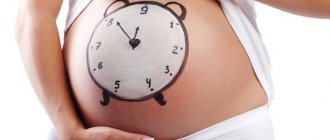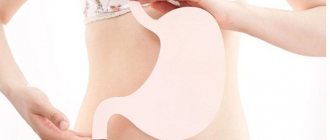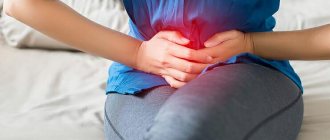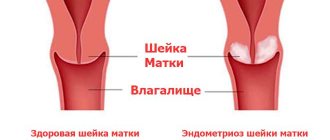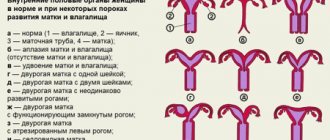Ovulation - the release of an egg from the ovary - is a natural and regular process in the female body. In the middle of the menstrual cycle, the dominant follicle matures to the desired size and ruptures under the influence of female sex hormones, and the egg is released into the abdominal cavity. And although most women do not even notice such changes inside their body, some of the “lucky ones” feel their ovulation very noticeably. There is discomfort, pain in the abdomen, in the side, spotting and other troubles - all these symptoms indicate ovulatory syndrome .
- Causes of ovulatory syndrome
- Symptoms of ovulatory syndrome
Causes
Ovulatory syndrome develops as a result of hormonal imbalance or local changes.
Physiological causes of pathology:
The growth of the maturing follicle leads to overstretching of the ovarian capsule and the appearance of pain.- When the follicle ruptures, the nerve endings located in the ovarian membrane are excited. From the receptors along the nerve fibers, the corresponding impulses enter the cerebral cortex. They are the ones who signal ovulatory pain.
- The fallopian tubes contract intensely as the egg moves into the uterus. Such peristalsis of the fallopian tubes is sometimes accompanied by painful sensations.
- When the follicle ruptures, blood and the aseptic fluid surrounding it enter the abdominal cavity. When the peritoneum is irritated, pain occurs.
Pathological causes of the syndrome - gynecological diseases:
- ovarian cysts,
- Chronic inflammation of the ovaries,
- Inflammation of the fallopian tubes,
- Adnexitis,
- Adhesive disease,
- Algodismenorrhea,
- Sexually transmitted infections
- Endometriosis.
The pain syndrome can increase significantly under the influence of certain factors:
- Stress, negative emotions, hysteria, neuroses,
- Physical fatigue
- Ovario-menstrual cycle disorders,
- History of frequent abortions
- Condition after cessation of hormonal contraception,
- Change of lifestyle and place of residence,
- Sleep disorders
- Avitaminosis and hypovitaminosis,
- Mental stress,
- Active sex in the middle of the cycle.
The influence of ovulatory syndrome on conception and pregnancy
If a woman does not have gynecological diseases, then ovulatory syndrome does not in any way prevent pregnancy. Problems may arise if discomfort in the middle of the cycle is caused by pathological reasons. The presence of adhesions can cause an ectopic pregnancy. Infectious diseases can provoke miscarriage in the early stages and pathologies of fetal development. Inflammation can prevent the embryo from attaching to the uterine cavity.
Some women note an indirect effect of ovulatory syndrome on conception. Directly during ovulation, severe pain appears that does not allow you to relax during sexual intercourse. This is a reason to refuse intimacy. Ultimately, the chances of conceiving are significantly reduced.
The process of fertilizing an egg
Pathogenesis
Ovulation is the process of release of a mature egg from the follicle, regulated by sex hormones and neurotransmitters of the pituitary gland.
Normal stages of ovulation:
- A decrease in follicle-stimulating hormone and estrogens in the blood,
- Increase in luteinizing hormone and progesterone,
- Follicle rupture
- The release of the egg
- It is captured by the villi of the fallopian tube and moved into the uterine cavity.
Ovulation occurs in women of reproductive age every month on the 14th day of the menstrual cycle. This process is regulated by hormones of the hypothalamus and pituitary gland through universal feedback between them and the ovaries.
If the concentration of certain hormones in the blood is insufficient, rapid rupture of the follicle occurs. With relative hypoestrogenemia, minor changes are observed at the level of the endometrium: it partially exfoliates. This leads to the development of ovulatory syndrome with a corresponding clinical picture - pain and spotting.
Local inflammatory and adhesive processes in the tubes lead to improper movement of the egg, compaction of the ovarian capsule and the wall of the fallopian tubes. Rupture of inflamed tissue and peristalsis of dense fallopian tubes are accompanied by pain.
Possible complications
The syndrome itself does not cause consequences unless secondary diseases are identified. Correct diagnosis allows you to prescribe treatment on time and avoid consequences.
Ovulation pain has symptoms similar to serious inflammatory processes. The formation of adhesions threatens further obstruction of the fallopian tubes, and this is a direct path to infertility.
The consequences of ovulatory syndrome manifest themselves:
- decreased attraction to a partner;
- development of depression;
- suppression of business activity;
- apoplexy of the ovaries.
Symptoms
Normally, the ovulation process is imperceptible. Usually women do not even suspect when exactly their egg is released. They are energetic, play sports, swim, visit discos and other public places, in a word, they lead an active lifestyle. Only some may experience a slight increase in the amount of serous discharge from the uterus. But there are those who are less fortunate - painful ovulation “haunts” them every time. Intense abdominal pain deprives a woman of all her usual joys, the ability to carry out everyday activities and even have sex.
Despite the fact that ovulatory syndrome is not accompanied by organic changes in the organs of the reproductive system, it can cause functional problems in the body.
Clinical signs of ovulatory syndrome:
- The pain is often one-sided, localized in the lower abdomen and radiating to the groin and sacrolumbar region. It intensifies during walking, coitus, physical activity, and sudden movements. The pain can be mild or sharp, long-term or short-term, pulling or stabbing.
- Scanty serous or bloody vaginal discharge is caused by a slight detachment of the endometrium caused by low estrogen levels and lack of progesterone.
- Increased libido during ovulation is associated with the nature of the female body. It is during this period that conception and procreation are possible.
- Soreness and sensitivity of the mammary glands is a sign of their preparation for pregnancy and subsequent lactation. Typically, chest pain does not last long and ends before the corpus luteum forms.
- Weakness, irritability and tearfulness. Emotional instability is associated with hormonal changes.
- Increase in body temperature to 37.5-37.7° C.
- In rare cases, nausea and vomiting.
- Swelling of the labia.
The pathological course of the ovulatory period does not pose a risk to a woman’s health. Its consequences affect mainly the emotional state and quality of life. Complications of ovulatory syndrome include: disruption of a woman’s daily activity, decreased libido, and depression. If a woman has adhesions in the fallopian tubes, their obstruction and infertility develop.
An emergency visit to a doctor is necessary in the presence of pronounced pain in the lower abdomen, which is combined with a progressive deterioration of the general condition, sudden fainting, profuse bleeding from the vagina, painful nausea and repeated vomiting, fever, chills and other symptoms lasting more than 2 days.
Signs
Ovulation syndrome (Mittelschmerz) is characterized by pain in the lower abdomen and pelvis, which occurs approximately in the middle of a woman’s menstrual cycle. Appears suddenly. It usually goes away within a few hours, sometimes it lasts two or three days.
In some cases it may continue until the next cycle. For some women, ovulatory symptoms are localized enough that it is possible to determine which of their two ovaries released an egg in a given month.
Since ovulation occurs in a random ovary each cycle, the discomfort switches to the other side or remains on one side from one cycle to the next.
Diagnostics
Diagnosis of ovulatory syndrome begins with collecting anamnesis and studying clinical signs.
Experts ask the woman:
- Time of appearance of the first symptoms and their severity,
- Reaction to antispasmodics or analgesics,
- Duration of the menstrual cycle,
- The day of the cycle when the pain occurred.
In most cases, more detailed diagnostics are not required. But if a woman has an irregular cycle and there is no connection between symptoms and ovulation, clarifying research methods are necessary.
- Gynecological examination in a chair.
- General blood analysis.
- Measurement of basal temperature, which during ovulation increases in the vagina and rectum by almost 1° C.
- Ultrasound of the ovaries allows you to observe the growing follicle and determine its size at the time of ovulation.
- Determination of the level of sex hormones - increase in luteinizing hormone and decrease in estrogen.
- Vaginal ultrasound of the pelvic organs.
- Tomographic study.
- Laparoscopic examination.
- Puncture of the posterior vaginal fornix.
- Microbiological examination of vaginal discharge for microflora.
- PCR diagnostics.
- Additional consultation with a surgeon and urologist.
Laboratory and instrumental diagnostic methods make it possible to exclude acute conditions masquerading as ovulatory syndrome - appendicitis, renal colic and others. This is especially important for women planning pregnancy.
conclusions
You're probably well aware of the stomach and back pain that can come with your period - thank goodness for hot water bottles and chocolate! However, you may also experience pain or discomfort for a day or two when ovulation occurs. That is the time when you can get pregnant.
Ovulation occurs between the two periods, which is about 14 days of the cycle. For some women, this is a burden. The good news is that it doesn't last more than a day or so.
Typical remedies such as ibuprofen, heating pads help if you have ovulatory syndrome. If the discomfort is more intense, anything that suppresses ovulation will provide relief. Any contraceptive method will help - for example, NuvaRing, Nexplanon implant to suppress ovulation. But keep in mind that non-hormonal methods such as the IUD will not help.
If pain during ovulation is not normal for your typical cycle, talk to your doctor to rule out more serious conditions. When the disorder interferes with daily activities, it may be a sign of another condition, such as an ovarian cyst, endometriosis, or pregnancy.
If in doubt, ask your gynecologist. Believe me, there are no questions that the doctor has not heard yet!
by Caitlin Fitzpatrick, Ian Sheehan.
Sources
Kippley, John; Sheila Kippley (1996). The Art of Natural Family Planning (4th ed.). Cincinnati, OH: League for Couples. pp. 83–84. ISBN 0-926412-13-2.
Weschler, Toni (2002). Taking charge of your fertility (Ed. Ed.). New York: HarperCollins. pp. 65–68, 228. ISBN 0-06-093764-5.
Michael H. Ross; Wojciech Pavlina (2006). Histology: text and atlas (5th ed.). Hagerstown, MD: Lippincott Williams and Wilkins. item 788. ISBN 978-0-7817-7221-1.
O'Herlihy, C.: Preovulatory follicle size: comparison of ultrasound and laparoscopic measurements. Fertil Sterile, 34: 24-6. 1980.
McSweeney, DJ: Ovulation and postovulatory pain. In J Obstet Gynecol 59: 419–23. 1950.
Kerin, JF, et al: Morphofunctional relationships of Graafian follicular growth to ovulation in women using ultrasound, laparoscopic and biochemical measurements. Br J Obstet Gynaecol. 88: 81-90. 1981.
Treatment
There is no specific treatment for ovulatory syndrome. Women are prescribed symptomatic therapy aimed at eliminating pain.
- Gynecologists recommend taking analgesics and antispasmodics during ovulation - “Baralgin”, “Solpadein”, “No-shpu”, “Spazmalgon”.
- To relieve pain, it is possible to use NSAIDs - Ibuprofen, Nurofen, Nise, Ketoprofen, Naproxen, Indomethacin.
- Long-term use of oral contraceptives prevents pain. They are prescribed for existing hormonal deficiency, which is the cause of vaginal discharge.
- Vitamin-mineral complexes and restoratives have a beneficial effect on the female body during ovulation.
- Physiotherapeutic methods are used in the absence of signs of acute inflammation. Warming compresses and a heating pad on the abdomen significantly reduce the intensity of pain. Warm baths using aromatic oils or medicinal plants will also help relieve pain.
- Experts recommend maintaining sexual rest during ovulation and completely eliminating physical activity.
- Traditional medicine that allows you to get rid of the manifestations of ovulatory syndrome include: baths with infusion of chamomile and cinnamon, a tampon from an infusion of calendula herb, celery juice for oral administration, an infusion of horsetail and lemon balm, an infusion of boron uterus and strawberries, an infusion of water pepper and nettle.
Therapy
Treatment for ovulatory syndrome is usually not carried out, since it is considered a normal variant and indicates the presence of ovulation. If pain occurs, you can take analgesic or non-steroidal anti-inflammatory drugs. The latter suppress the release of prostaglandins that contribute to its formation.
But if the pain and/or bleeding is prolonged, intense, accompanied by nausea, vomiting and/or persists for 1 day or longer, you should definitely consult a doctor. This is necessary for the purpose of differential diagnosis of ovulatory syndrome with ectopic pregnancy, ovarian apoplexy or torsion of its pedicle, appendicitis, perforation of the intestinal diverticulum, calculus in the ureter and other diseases.
If the symptoms of the syndrome recur frequently, after examination and at the request of the woman (taking into account pregnancy planning), the gynecologist may recommend taking oral contraceptives.
Prevention and prognosis
Preventive measures for ovulatory syndrome are nonspecific. They consist of implementing the following recommendations:
- Controlling the duration of the menstrual cycle,
- Visiting a gynecologist 2-3 times a year,
- Using condoms to prevent unwanted pregnancy and sexually transmitted infections
- Refusal of abortions and unnecessary invasive procedures,
- Good rest, normal sleep, healthy eating,
- Prevention of stress and neuroses,
- Optimization of physical activity,
- Frequent walks in the fresh air,
- Drink plenty of fluids
- Fighting bad habits
- Compliance with the rules of personal hygiene and intimate life,
- Regular sexual relations with one sexual partner,
- Timely detection and treatment of inflammatory diseases of the female reproductive system.
The prognosis for ovulatory syndrome is favorable in any case. This functional impairment is easily corrected or goes away on its own.
Ovulatory syndrome is a common complaint among women of reproductive age. It disrupts their daily activities and reduces their performance. If pain occurs during ovulation and other symptoms, you should consult a doctor. Ovulatory syndrome is a functional disorder that can be easily corrected and has a favorable prognosis. However, its symptoms may hide formidable pathological processes. Appendicitis, some cancers, and pathologies in the pelvis have similar manifestations. That is why only a qualified specialist can decide on the need for treatment.
Who is more susceptible to the syndrome?
This condition can occur in women of any age, but more often in those over 50 years old. At this age, pain during ovulation occurs due to:
- Infectious diseases. Transmitted through sexual contact;
- Oral contraceptives are discontinued;
- Endometriosis;
- Constant stress and depression;
- Sleep disorders;
- Few vitamins and minerals in the body. Occurs due to gastrointestinal diseases, various diets;
- Too much physical activity;
- Abortion;
- Serious mental load.
Such problems can cause painful ovulation.

